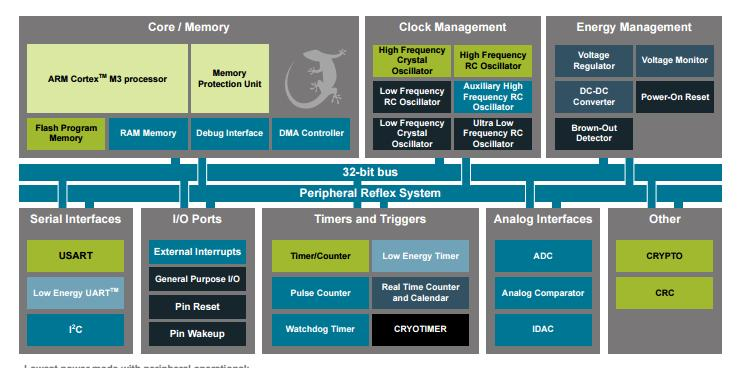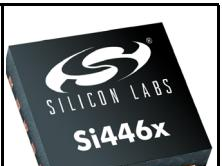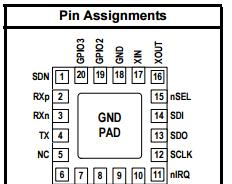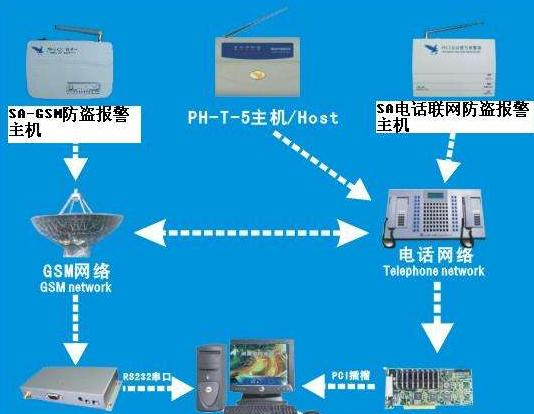基于EFM32JG/Si446x主控器件的超低功耗远程无线联网报警系统解决方案
 458
458
 拍明
拍明
方案概述
智能安防无线报警系统,一般由无线报警主机和各类节点设备组成。节点设备的状态信息和报警信息通过无线通信方式上传给无线报警主机,节点设备一般采用电池供电,因而延长电池寿命就变得非常重要;同时报警系统采用无线通信方式,要使通信距离更远,可增加发射功率,但是发射功率的增加必然会带来功耗的上升。因此,如何实现最优的性能、最长的电池寿命和最佳的用户体验,设计者在一开始就需要考虑到方案低功耗的每一处设计细节。
器件优势
• 具备高性能超低功耗32bit MCU EFM32JG( 60uA/MHz 运行功耗, 1.4uA EM2模式睡眠功耗),延长电池使用寿命,可支持AES等硬件数据加密,具备高效、安全的数据处理能力;
【EFM32JG】
EFM32 Jade Gecko MCU 是全球最节能的微控制器。
EFM32JG1 采用了强大的 32 位 ARM® Cortex®-M3 以及广泛的外围设备选择,包括支持
AES、ECC 和 SHA 的独特加密硬件引擎。这些功能结合超低电流有源模式,再加上能够从
节能模式快速唤醒,使得 EFM32JG1 微控制器既适用于任何电池供电的应用,也适合有着
高性能和低能耗要求的其他系统。
应用示例:
节能
• ARM Cortex-M3(功率为 40 MHz)
• 极低能耗操作:
• 在 EM3 停止模式下,电流为 2.1 μA(CRYOTIMER 运行,状态/RAM 保留)
• 在 EM2 深度睡眠模式下,电流为 2.5μA(RTCC 运行,状态/RAM 保留)
• 在能源模式 0 (EM0) 下,运行功耗为63 μA/MHz
• 支持 AES、ECC 和 SHA 的硬件加密引擎
• 集成直流对直流转换器
• CRYOTIMER 运行低至 EM4 模式
• 5V 容限 I/O
• 物联网设备和传感器
• 健康和健身设备
• 智能附件
• 住宅自动化和安全
• 工业及工厂自动化

EFM32JG1 的重要功能如下所列。
• ARM Cortex-M3 CPU 平台
• 32-位高性能处理器(高达 40 MHz)
• 存储器保护单元
• 唤醒中断控制器
• 灵活的电能管理系统
• 能源模式 0 (EM0) 下,运行耗能为 63 μA/MHz
• 在 EM2 深度睡眠模式(RTCC 运行,状态/ARM 保留)下,电流为 2.5 μA
• 在 EM4H 休眠模式(RAM 保留 128 字节)下,电流为 0.58μA
• 高达 256 kB 闪存程序存储器
• 32 kB RAM 数据存储器
• 多达 32 个通用 I/O 引脚
• 可配置的推挽、开漏、上拉/下拉、输入滤波器和驱动强度
• 可配置的外围设备 I/O 位置
• 异步外部中断
• 输出状态保留和从关机模式唤醒
• 硬件加密
• AES 128/256-位秘钥
• ECC B/K163、B/K233、P192、P224、P256
• SHA-1 和 SHA-2 (SHA-224 和 SHA-256)
• 定时器/计数器
• 2 个 16 位定时器/计数器
• 3 + 4 比较/捕获/PWM 通道
• 1 个 32-位实时计数器和日历
• 1 个 32-位超低耗能 CRYOTIMER,可从任何能源模式定期唤醒
• 16-位低耗能计时器,用于生成波形
• 16-位脉冲计数器,带有异步操作
• 监视程序定时器,配有专用 RC 振荡器
• 8 信道 DMA 控制器
• 12 信道外围设备反射系统 (PRS),用于 外围设备之间自主传输信号
• 通信接口
• 2 个通用同步/异步接收器/ 发射器
• UART/SPI/SmartCard (ISO 7816)/IrDA/I2S/LIN
• 三重缓冲全双工/半双工操作(带流量控制)
• 低功耗 UART
• 在深度睡眠模式下利用 DMA 进行自主操作
• I2C 接口(带 SMBus 支持)
• 停止模式 (EM3) 下的地址识别功能
• 超低功耗精密模拟外围设备
• 12 位 AD 转换器(1 M 样本/s)
• 2 个模拟比较器
• 数字模拟电流转换器
• 多达 32 个引脚,连接至模拟比较器、ADC 和 IDAC 共用的模拟信道 (APORT)
• 超高效加电复位和欠压检测器
• 调试接口
• 2 引脚串行线调试接口
• 1 引脚串行线查看器
• JTAG(仅用于编程)
• 较宽工作范围
• 单电源供电 1.85 V 至 3.8 V
• 集成直流对直流,输出电压低至 1.8 V,系统负载电流高达200 mA
• 标准温度等级(-40 °C 至 85 °C TAMB)和扩展温度等级(-40 °C 至 125 °C TJ)可供选择
• 封装
• 7 mm × 7 mm QFN48
• 5 mm × 5 mm QFN32
• 预编程 UART 引导装载程序
• 完整软件支持
• CMSIS 寄存器定义
• 低功耗硬件抽象层 (HAL)
• 便携式软件组件
• 第三方中间件
• 可免费获取的代码示例
• 具备远距离低功耗无线射频收发器Si446x,-129dbm的超高接收灵敏度,10dbm发射功率下传输距离大于1千米。10dbm发射功率下工作电流18mA,接收电流约3mA(PSM功能开启),适用电池供电的产品设计。
【Si446x】


Si446x/Si4362 RX LNA Matching
1. Introduction
The purpose of this application note is to provide a description of the impedance matching of the RX differential lownoise amplifier (LNA) on the Si446x/Si4362 family of RFICs.
It is desired to simultaneously achieve two goals with the matching network:
>Match the LNA input to the antenna source impedance (e.g., 50
>Provide a single-ended-to-differential conversion function (i.e., a balun)
The matching procedure outlined in this document provides for achieving the goals listed above.For those users who are not interested in the theoretical derivation of the match network, but are just concernedwith quickly obtaining matching component values, refer to the Summary Tables shown in "4.1.7. Summary Tablesof 3-Element Match Network Component Values vs. Frequency" on page 12 and "4.2.7. Summary Tables of 4-Element Match Network Component Values vs. Frequency" on page 19.
Measurements were performed on the Si4461-B0 chip but are applicable to other members of the Si446x family ofchips (e.g. Si446x-B1, C0, C1, C2 and the Si4362 chip).
2. Match Network Topology
The LNA on the Si446x/Si4362 family of chips is designed as a differential amplifier and thus has two input pins(RXp and RXn) on the RFIC. It is necessary to design a network that not only provides a conjugate match to theinput impedance of the LNA but also provides a balanced-to-unbalanced conversion function (i.e., a balun).
The LNA design is differential and thus the RXp and the RXn input pins may be considered interchangeable.Although the figures in this document may show the matching components connected to the RXp/RXn pins in acertain fashion, the pin connections may be reversed without change in functionality.Use of two basic matching network topologies will be considered within this application note.
2.1. Three-Element Match Network
The simplest match network that may be fabricated from discrete components is comprised of three discreteelements. Two forms of the 3-element match network may be constructed: one with a highpass filter (HPF)response, and one with a lowpass filter (LPF) response. However, the form with a lowpass filter response is notrealizable at all frequencies and input impedances. As a result, only the form with a highpass filter response isdiscussed within this document.
A 3-element (CR1-LR1-CR2) HPF matching network is shown in Figure 1. This matching network has the virtue ofrequiring a minimum number of components but results in slightly sub-optimal performance. It is not theoreticallypossible to achieve a perfectly balanced single-ended-to-differential conversion function with this matching networkfor input impedances with finite values of RLNA. As will be demonstrated, the waveforms obtained at the RXp and RXn inputs to the RFIC will not be exactly 180° out of phase; the result is a very slight loss in conversion gain in the LNA and a small drop in overall sensitivity of the RFIC. The reduction in performance is typically less than 0.5 dB;many customers may view this as an acceptable trade-off for the reduction in the bill of materials (BOM).
The RXp and RXn inputs of the Si446x/Si4362 RX LNA internally contain high value (~15 k) pull-down resistorsto GND. As a result, supplying a DC voltage to these pins is not recommended; use of external AC-coupling to these pins is suggested. This is inherently supplied by capacitor CR2 of Figure 1.
Si4463/Si4461/Si4460-C
Features
> Frequency range = 142–1050 MHz
> Receive sensitivity = –129 dBm
> Modulation
》(G)FSK, 4(G)FSK, (G)MSK
》OOK
> Max output power
》+20 dBm (Si4463)
》+16 dBm (Si4461)
》+13 dBm (Si4460)
> PA support for +27 or +30 dBm
> Low active power consumption
》10/13 mA RX
》18 mA TX at +10 dBm (Si4460)
> Ultra low current powerdown modes
》30 nA shutdown, 40 nA standby
> Preamble sense mode
》6 mA average RX current at
1.2 kbps
》10 µA average RX current at
50 kbps and 1 sec sleep interval
> Fast preamble detection
》1 byte preamble detection
> Data rate = 100 bps to 1 Mbps
> Fast wake and hop times
> Power supply = 1.8 to 3.8 V
> Excellent selectivity performance
》69 dB adjacent channel
》79 dB blocking at 1 MHz
> Antenna diversity and T/R switch control
> Highly configurable packet handler
> TX and RX 64 byte FIFOs
》129 bytes dedicated Tx or Rx
> Auto frequency control (AFC)
> Automatic gain control (AGC)
> Low BOM
> Low battery detector
> Temperature sensor
> 20-Pin QFN package
> IEEE 802.15.4g and WMBus compliant
> Suitable for FCC Part 90 Mask D, FCCpart 15.247, 15,231, 15,249, ARIB T-108,T-96, T-67, RCR STD-30, China
regulatory
> ETSI Category I Operation EN300 220
Applications
> Smart metering (802.15.4g and WMBus)
> Remote control
> Home security and alarm
> Telemetry
> Garage and gate openers
> Remote keyless entry
> Home automation
> Industrial control
> Sensor networks
> Health monitors
> Electronic shelf labels
Description
Silicon Laboratories' Si446x devices are high-performance, low-currenttransceivers covering the sub-GHz frequency bands from 142 to 1050 MHz. Theradios are part of the EZRadioPRO® family, which includes a complete line oftransmitters, receivers, and transceivers covering a wide range of applications. Allparts offer outstanding sensitivity of –129 dBm while achieving extremely lowactive and standby current consumption. The Si4463/61/60 offers frequencycoverage in all major bands. The Si446x includes optimal phase noise, blocking,and selectivity performance for narrow band and wireless MBus licensed bandapplications, such as FCC Part90 and 169 MHz wireless Mbus. The 69 dBadjacent channel selectivity with 12.5 kHz channel spacing ensures robustreceive operation in harsh RF conditions, which is particularly important for narrowband operation. The Si4463 offers exceptional output power of up to +20 dBmwith outstanding TX efficiency. The high output power and sensitivity results in anindustry-leading link budget of 146 dB allowing extended ranges and highly robustcommunication links. The Si4460 active mode TX current consumption of 18 mAat +10 dBm and RX current of 10 mA coupled with extremely low standby currentand fast wake times ensure extended battery life in the most demandingapplications. The Si4463 can achieve up to +27 dBm output power with built-inramping control of a low-cost external FET. The devices can meet worldwideregulatory standards: FCC, ETSI, wireless MBus, and ARIB. All devices aredesigned to be compliant with 802.15.4g and WMbus smart metering standards.
The devices are highly flexible and can be configured via the WirelessDevelopment Suite (WDS) available on the Silicon Labs website.
【联网报警系统】
联网报警系统(lian wang bao jing xi tong)是指运营商在自己的监控室搭建一套报警管理平台,给需要安装防盗报警系统的商户装上联网报警器和探测设备,通过联网报警软件将这些分散的报警器探测到的警情通过各种传输方式传到管理平台,统一由中心平台来处理警情,并由运营商运作体系对警情进行即时的处理,以至于各大商铺免受损失。

为了有力的打击犯罪分子,居民社区增设了网络安全防范报警系统以及派出所辖区的联网报警系统。
联网报警系统一般由用户报警控制核心设备(防盗报警系统),防盗报警器、防盗报警配件和电源适配模块组成。防盗报警主机通过无线/有线通讯方式实现与各种报警探测器的信号交互,主机接收到探测器的报警信号后,通过告警模块自动呼叫或网络上传联网报警系统上报报警信息。此外,防盗报警主机本身集成或通过专门接口与声光报警器相连,实现现场报警。当客户端报警主机(包括红外探测器,门磁,烟感,红外对射,紧急按钮等各种探测器和摄像机)发生报警时,迅速将警讯或现场视频图像通过公用PSTN/GPRS/Internet待方式传输到联网报警系统服务器,数据处理终端的电子地图上会自动弹出警情信息,由联网报警接警中心人员派出巡防员或联动联网报警指挥中心出警。
责任编辑:Davia
【免责声明】
1、本文内容、数据、图表等来源于网络引用或其他公开资料,版权归属原作者、原发表出处。若版权所有方对本文的引用持有异议,请联系拍明芯城(marketing@iczoom.com),本方将及时处理。
2、本文的引用仅供读者交流学习使用,不涉及商业目的。
3、本文内容仅代表作者观点,拍明芯城不对内容的准确性、可靠性或完整性提供明示或暗示的保证。读者阅读本文后做出的决定或行为,是基于自主意愿和独立判断做出的,请读者明确相关结果。
4、如需转载本方拥有版权的文章,请联系拍明芯城(marketing@iczoom.com)注明“转载原因”。未经允许私自转载拍明芯城将保留追究其法律责任的权利。
拍明芯城拥有对此声明的最终解释权。




 产品分类
产品分类















 2012- 2022 拍明芯城ICZOOM.com 版权所有 客服热线:400-693-8369 (9:00-18:00)
2012- 2022 拍明芯城ICZOOM.com 版权所有 客服热线:400-693-8369 (9:00-18:00)


